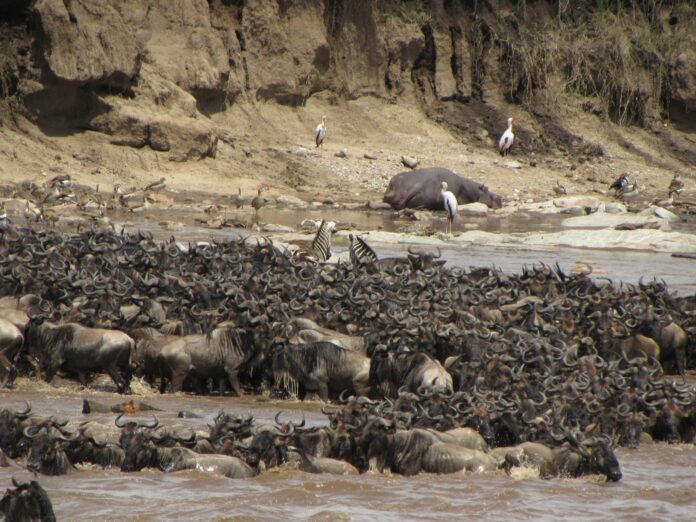Introduction to the Wildebeest Migration
The wildebeest migration is more than just an animal movement — it’s an awe-inspiring display of survival, instinct, and nature’s balance. Every year, over 1.5 million wildebeests, accompanied by hundreds of thousands of zebras and gazelles, embark on a massive journey across the Serengeti-Maasai Mara ecosystem. This annual spectacle is considered one of the Seven Natural Wonders of Africa, attracting thousands of wildlife enthusiasts and photographers from around the globe.
What is the Wildebeest Migration?
In simple terms, the wildebeest migration is the cyclical movement of massive herds between Tanzania’s Serengeti National Park and Kenya’s Maasai Mara National Reserve. The driving force? Food and water. As the East African seasons shift, fresh pastures and water sources emerge in different regions, prompting these animals to travel in a predictable — yet perilous — path.
Why It’s Considered One of the Seven Natural Wonders of Africa
The migration is often called the world’s largest overland migration. The sight of thundering hooves, endless plains, and life-or-death river crossings is unmatched. For predators, it’s a buffet; for the wildebeests, it’s a test of endurance and survival. Scientists, photographers, and travelers alike rank it among the most extraordinary wildlife events on the planet.
Geographic Overview of the Wildebeest Migration Path
The wildebeest migration covers a 1,200-mile circuit through some of Africa’s most iconic landscapes.
Serengeti National Park (Tanzania)
The journey begins in the southern Serengeti, where vast grasslands provide perfect grazing grounds during calving season. This UNESCO World Heritage Site is the heart of the migration.
Maasai Mara National Reserve (Kenya)
By mid-year, the herds cross into the Maasai Mara in search of lusher grazing lands. The Mara is famed for its dramatic predator encounters and open savannah beauty.
Key Rivers: Mara River and Grumeti River
These rivers pose the most dangerous hurdles in the migration. Crossing them means facing strong currents and predators like Nile crocodiles — a make-or-break moment for many animals.
The Annual wildebeest Migration Cycle
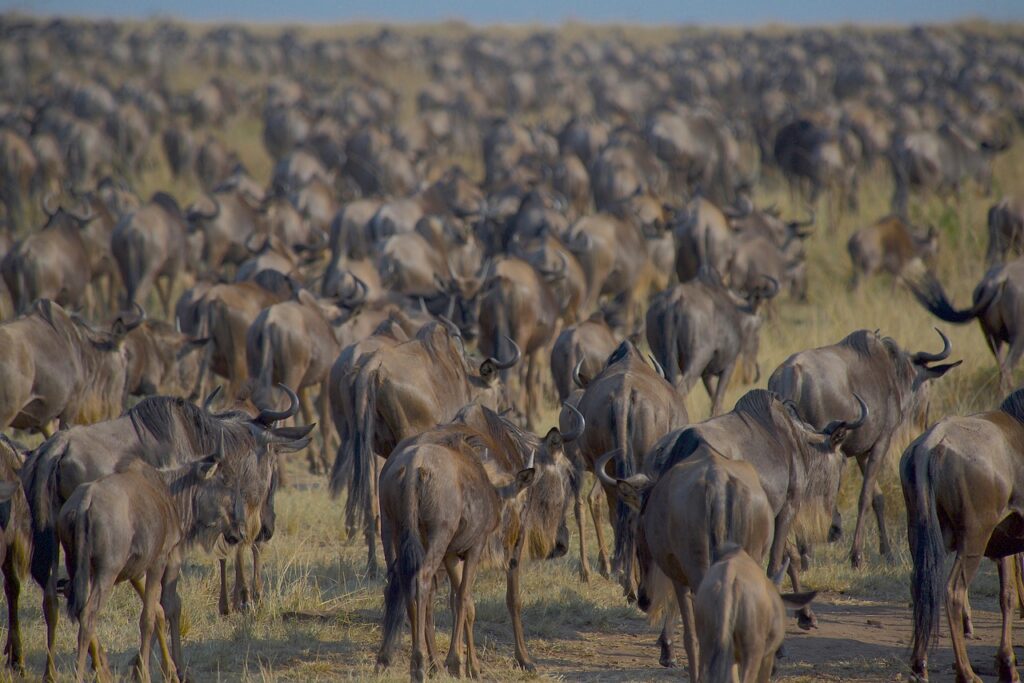
The wildebeest migration follows a predictable yet perilous cycle driven by rainfall patterns and grass growth. This natural rhythm ensures the survival of millions of animals but also exposes them to danger every step of the way.
January–March: Calving Season
The southern Serengeti becomes a nursery during these months. Around 500,000 calves are born within a short 3–4 week period, often at the same time. This synchronicity overwhelms predators like lions, hyenas, and cheetahs, ensuring many young survive.
The fresh, mineral-rich grasses of the Ndutu region make this an ideal birthing ground. However, for newborn calves, the journey ahead will be their first—and toughest—life test.
April–June: The Long Trek North
As the short rains end, the grasses in the south dry up. The herds begin moving north-west toward the Grumeti River, facing a marathon trek.
During this time, the migration stretches for miles, and predators take advantage of the long, slow-moving columns. The Grumeti River crossings begin, where massive Nile crocodiles lurk.
July–September: The Great Mara River Crossing
This is the most famous—and most dangerous—stage of the migration. The Mara River in northern Serengeti and southern Maasai Mara is swollen from seasonal rains. Herds gather in massive numbers on the banks, often hesitating for hours before one brave wildebeest makes the leap.
The crossing is chaotic: drowning, stampedes, and crocodile attacks are common. For wildlife photographers, this is the defining moment of the migration.
October–December: The Return Journey
As the rains shift southward, the herds begin their journey back to the Serengeti. The grasslands replenish, and the cycle begins anew. This return leg is equally dangerous, as predators still stalk the weakened animals.
Wildlife Involved with Wildebeests Migration
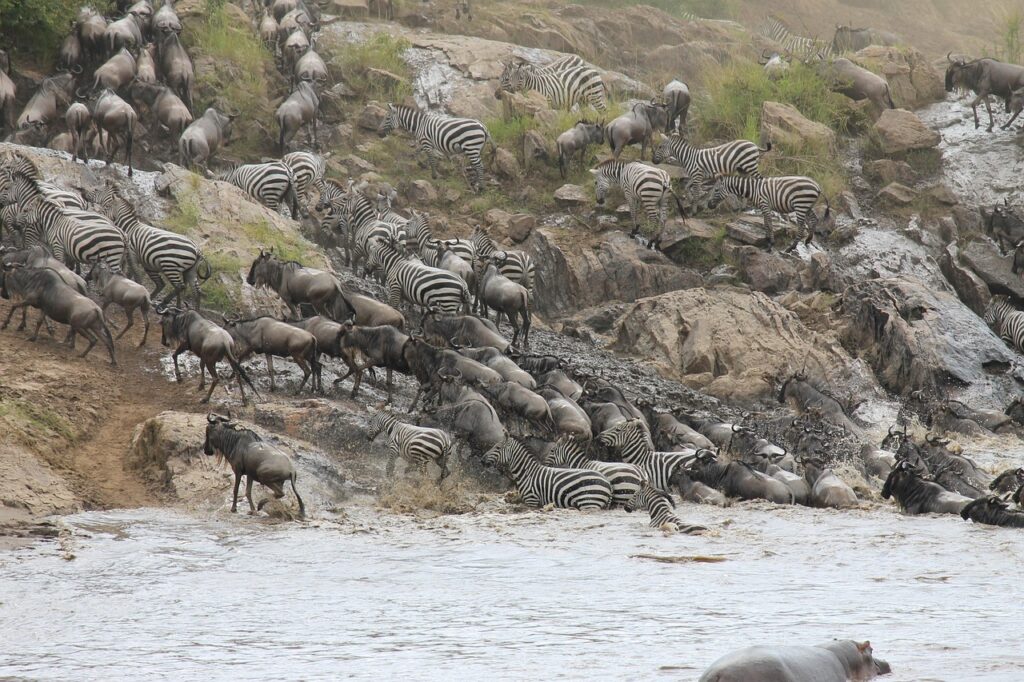
Although the wildebeests dominate the migration, they’re far from alone.
Wildebeests as the Main Players
These antelope-like grazers make up about 80% of the migration herd. Their instinctual navigation—possibly influenced by the position of the sun, smell of rain, and memory of past routes—ensures the cycle continues year after year.
Zebras, Gazelles, and Other Migratory Companions
Zebras travel alongside wildebeests, benefiting from their grazing habits, while gazelles join for safety in numbers. Together, they create one of the densest concentrations of herbivores on Earth.
Predators Following the Herds
Lions, leopards, hyenas, cheetahs, and crocodiles track the migration. For them, the moving herds are a rolling feast, ensuring predator populations thrive.
Ecological Importance of the wildebeest Migration
The wildebeest migration isn’t just a visual spectacle—it’s vital for the ecosystem.
Nutrient Recycling and Grassland Health
As herds graze and move on, they leave behind natural fertilizer. This constant cycle maintains the grassland’s health, promoting biodiversity.
Predator-Prey Dynamics
Without the migration, predator populations would plummet. The vast herds sustain carnivores year-round, ensuring a balanced ecosystem.
Challenges and Threats to the Wildebeest Migration
While the migration has endured for thousands of years, it’s now under threat.
Climate Change and Droughts
Erratic rainfall patterns can disrupt grazing cycles, affecting calf survival and predator-prey balance.
Human Encroachment and Poaching
Fencing, farming, and expanding towns can block migration routes. Poaching adds another layer of danger.
River Crossings and Natural Dangers
Even without human interference, the migration is treacherous. Stampedes, drowning, and crocodiles claim countless lives each year.
Best Time and Places to Witness the Migration
Timing is everything if you want to see this natural wonder in person.
Ideal Months for Different Stages
- January–March: Calving season in Ndutu (Southern Serengeti)
- June–July: Grumeti River crossings
- July–September: Mara River crossings
- October–November: Return migration through Central Serengeti
Top Safari Spots for Viewing
- Ndutu Plains, Tanzania
- Grumeti River, Tanzania
- Northern Serengeti, Tanzania
- Maasai Mara, Kenya
Travel Tips for Witnessing the Migration
A migration safari requires planning and timing.
Choosing the Right Safari Package
Opt for mobile camps that move with the herds, ensuring you’re always close to the action.
Packing Essentials for a Migration Safari
Bring binoculars, a good camera, lightweight clothing, insect repellent, and plenty of memory cards.
Responsible Wildlife Tourism
Book with eco-friendly operators who respect wildlife and support conservation efforts.
Fascinating Facts About the Wildebeest Migration
- Over 1.5 million wildebeests take part each year.
- The migration covers up to 1,200 miles annually.
- Wildebeests can run at speeds of up to 50 mph.
- Calves can stand and run within minutes of birth.
- The journey is so vast it can be seen from space.
FAQs About the Wildebeest Migration
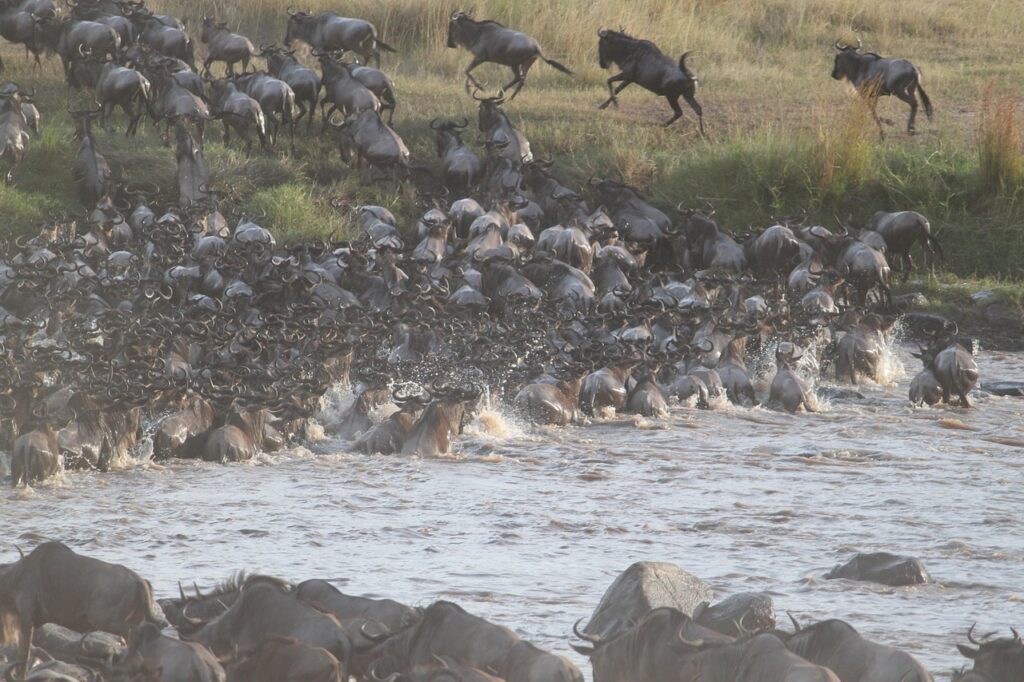
Q1: How long does the wildebeest migration last?
A: It’s a year-round event, though different stages happen in different months.
Q2: When is the best time to see the Mara River crossing?
A: July–September offers the most dramatic crossings.
Q3: Is the migration the same every year?
A: While the route is similar, exact timings vary due to rainfall.
Q4: Do all wildebeests survive the migration?
A: No. Thousands perish due to predators, exhaustion, and river dangers.
Q5: Can you track the migration live?
A: Yes. Many safari companies offer real-time updates and GPS tracking.
Q6: How important is the migration to the ecosystem?
A: It’s essential—it supports predator populations, fertilizes the soil, and sustains grassland biodiversity.
Conclusion
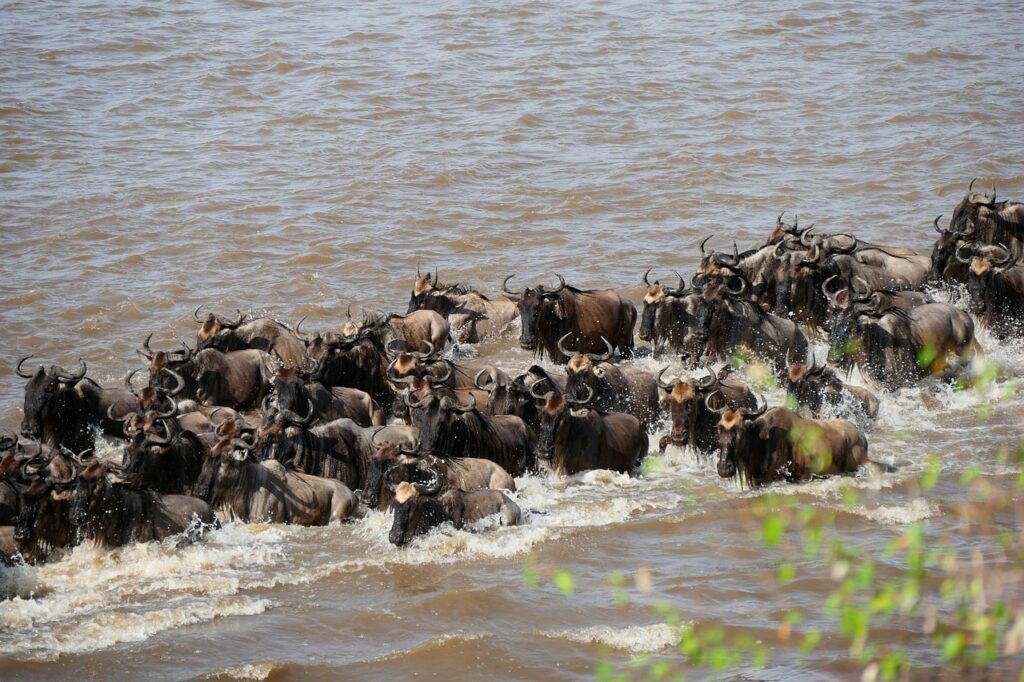
The wildebeest migration is more than a wildlife event—it’s a living, breathing heartbeat of Africa’s savannahs. It’s a reminder of nature’s power, resilience, and interconnectedness. Whether you witness it in person or through the lens of a camera, it leaves an indelible mark on the soul.
For a deeper dive into conservation and safari planning, please visit Serengeti National Park website.

